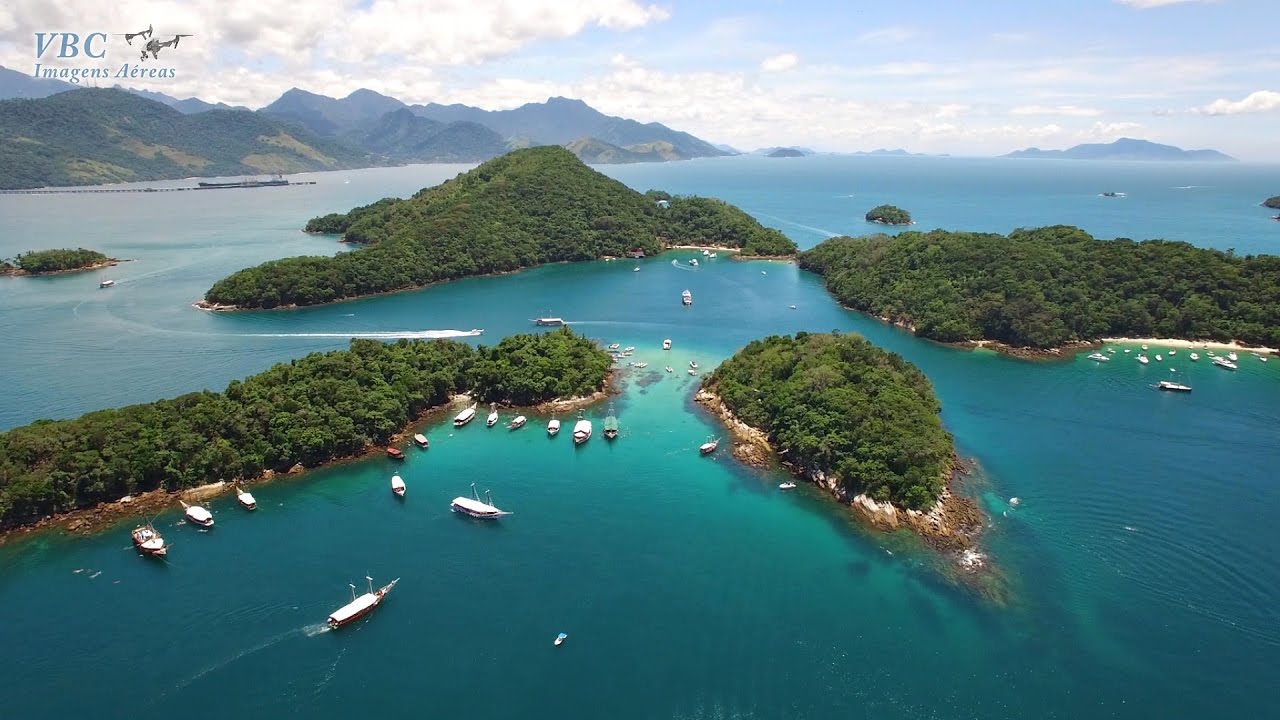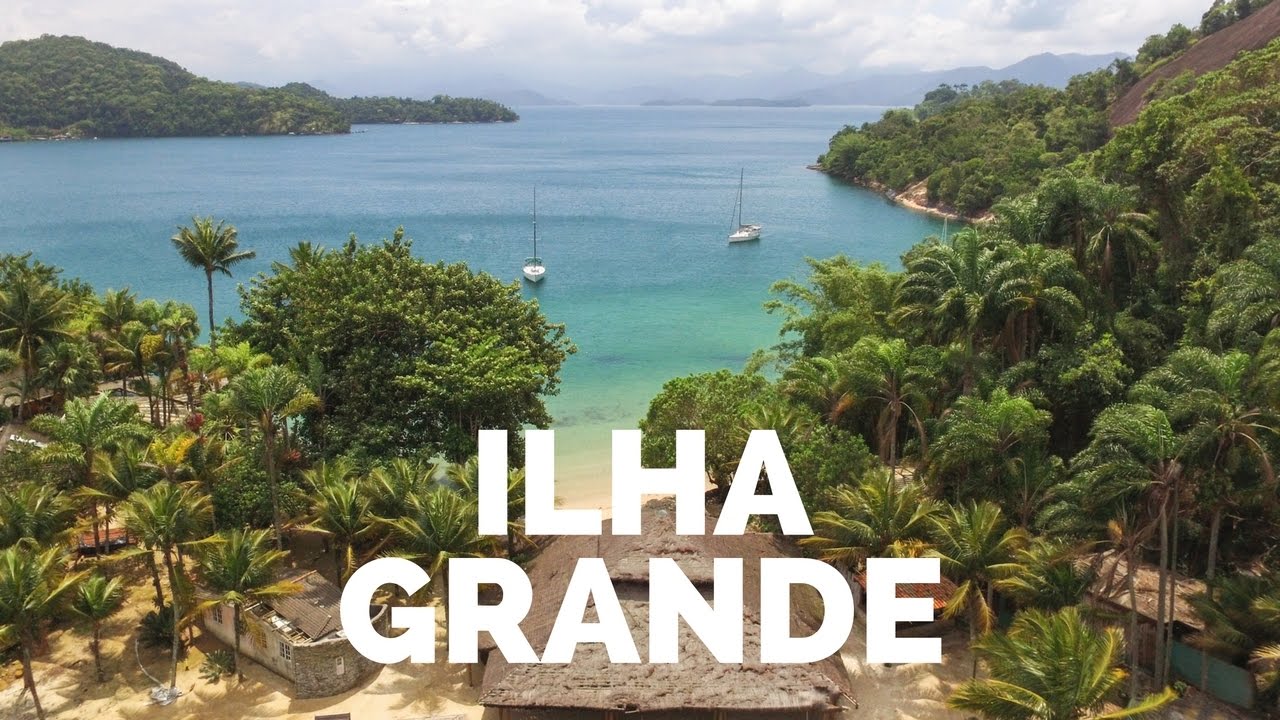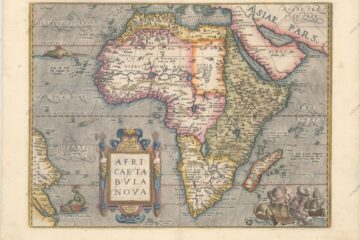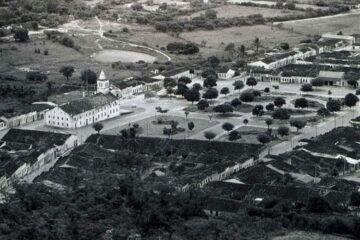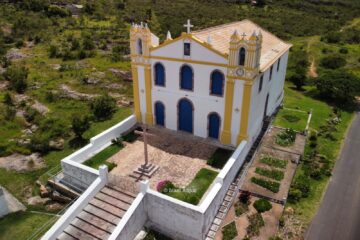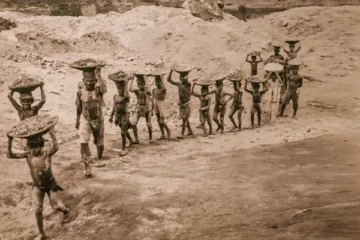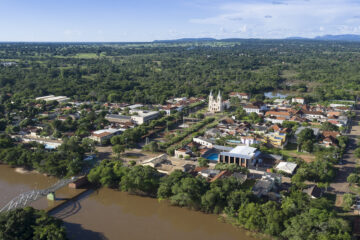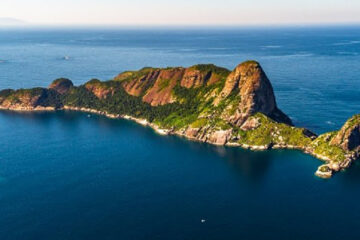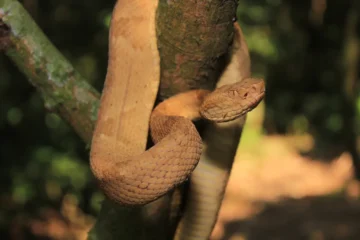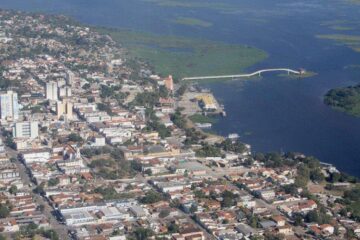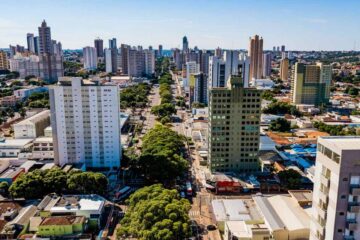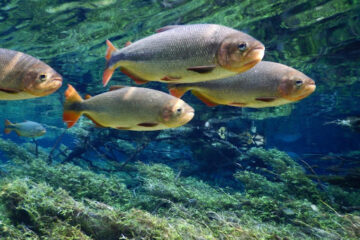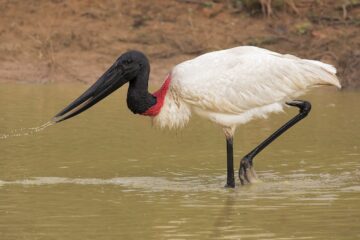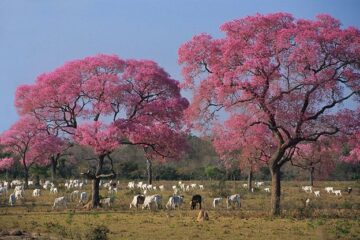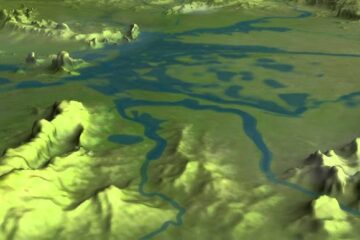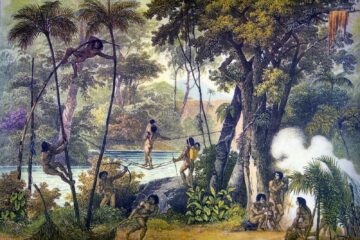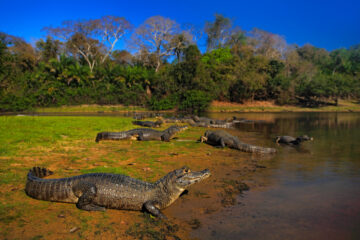Este post também está disponível em:
Português
English

Ilha Grande is a place full of natural beauty, located in the municipality of Angra dos Reis in the state of Rio de Janeiro.
With preserved nature, Ilha Grande is the right destination for those seeking adventure, beaches and nature.
Brazil with a coastline of more than 8000 km long offers several options of islands that can be visited by tourists.
Continental islands are Ilhabela, Ilha Grande and Santa Catarina Island and oceanic islands like Fernando de Noronha, Atol das Rocas, Archipelago of São Pedro and São Paulo and Trindade e Martim Vaz.
Discovered by the Portuguese navigator André Gonçalves in 1502, Ilha Grande was inhabited at the time by the traditional Indians of the region, the Tamoios.
Between the sixteenth and nineteenth centuries, with the development of Latin American colonization and the wars between the former colonizing powers became a strategic location for the slave trade and goods. Its fame gained international airs.
Map of Angra dos Reis and Ilha Grande RJ
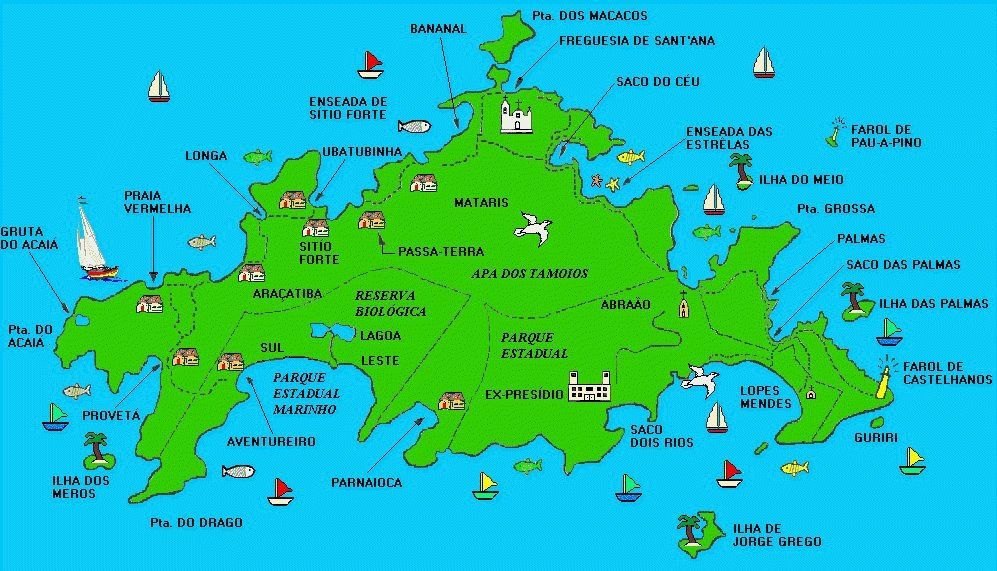
In more recent times two prisons on the island housed common and political detainees. Writers Graciliano Ramos, Orígenes Lessa and some famous revolutionaries of the “Communist Intent of 32” were detained there.
This mix of prisoners is now considered the cradle of national organized crime. A tip is to watch the movie “Almost Brothers”, by director Lucia Murat, which narrates exactly this passage of events.
Ilha Grande, located on the southwest coast of Rio de Janeiro, in the municipality of Angra dos Reis, is one of the country’s gems.
The preserved nature (and protected by law), the rustic climate, the local stories and legends and the fascinating landscapes that combine coves, rivers, lagoons, waterfalls, coasts, plains, islands, lush forest and mountains make the visitor enter the ferry back to the mainland with the feeling of crossing a portal and returning to a world less exciting than the one he has just left behind.
In all, the island has an area of 193 km², most of it covered by dense Atlantic forest. It has a rugged outline with 34 points, seven coves and 106 beaches.
Watch the videos about Ilha Grande

Sea and forest have combined over the centuries to create paradisiacal corners, some unreachable, others accessible only by boat or even by trails. Around it, other islands frame its beauty and almost all its surroundings have beaches suitable for visitation.
The climate and landscape encourage total idleness, however, there is much to do on Ilha Grande with options for all levels of adventure. The structure for this is well organized, making ecotourism the great vocation of this paradise.

To walk the trails, for example, there are signs and guidance signs along the way. There are everything from short and easy routes to options for those seeking real adventure, such as the trail that goes around the island and can be done in up to five days.
Not to mention the strongholds for professional diving (the bay is famous for shipwrecks visited by divers from all over the world) and the many nooks and crannies where beginners can glimpse large, red starfish and colorful fish.
With so much preserved area, Ilha Grande consists of a natural refuge for many animals and also protection of genetic resources of species typical of Atlantic formations. This is the case of the howler monkey, a primate with a serious risk of extinction that is protected there.
Schooner or speedboat rides take tourists to visit beaches and other tourist spots. It is the attraction that most moves commerce in the region, as it guarantees the visitor to know places that could only be reached by boat or by trail and guarantees the locals to earn some money by offering meals with a very homemade taste.
In the morning, the tourist pier of the village of Abraão, the “capital” of Ilha Grande, is bustling with tourists arriving and departing for their tours.
In all, about 7,500 people live on the island, including fishermen, foreigners who have put down roots and those who carry the legacy of their ancestors who came here, such as descendants of farmers.
The maximum the island can hold is 11,000 people. This leaves 4,500 “vacancies”, which are beds for legalized accommodation, including camping, which can only be practiced in authorized areas under strict supervision.
Villages and villages are spread across the beaches of the entire surroundings, totaling 21 communities, of which the village of Abraão, Provetá, the village of Dois Rios, Praia Grande de Araçatiba, Aventureiro, Lopes Mendes, Saco do Céu, Bananal, Praia da Longa, Ubatuba, Passa-Terra and Parnaioca stand out. Abraão alone has 1,821 inhabitants.
It is the largest of the whole island and concentrates a large network of accommodation and restaurants.
There are no bank branches in the village. The way is to leave the mainland with an amount of cash that you think is enough. Because of this, most establishments work with debit and credit cards.
Today, the island is famous for its natural beauty, but in the recent past it was nationally known for housing two prisons for convicts of common crimes and also for political prisoners, such as Graciliano Ramos and Fernando Gabeira.
It was nicknamed the “Brazilian Alcatraz”. Fortunately, beauty spoke louder and, today, the signs of this past are in ruins and their memories ferment the stories that the people tell.
Undoubtedly, the culture of Ilha Grande is full of legends and stories, but the most beautiful ones you will carry when you leave with the feeling that you need to go back and should have booked more days to get to know this great paradise.
How to get to Ilha Grande
Boats departing daily from Angra dos Reis or from the neighboring Mangaratiba make the crossing of tourists and campers to Ilha Grande. Approximately 1:30h after boarding you will be in Vila do Abraão, the tourist and commercial center of the island.
A company called “Barcas S.A” makes the crossing safely and the sea is usually calm. A small house next to the pier in the village of Abraão serves as a reception for visitors who from there can evaluate and choose the place and the most suitable pousada for their intention on the island.
The number of ferries and departure times is relatively small. The tip is to arrive in advance to be able to guarantee your place, especially on the eve of long holidays.
Map of Angra dos Reis and Ilha Grande RJ
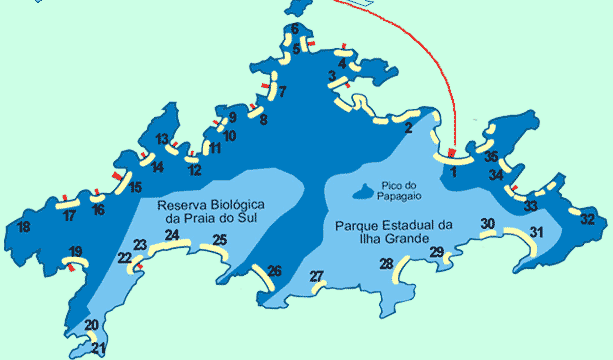
ILHA GRANDE BEACHES
1. VILA DO ABRAÃO

One of the oldest and most important villages of Ilha Grande. Abraão offers an urban infrastructure suitable for those seeking relaxation and harmony with nature.
Quality services in lodging (Pousadas and Campings) and good restaurants, besides being the only village to count on regular transportation. All this makes Abraão the most sought after village of Ilha Grande, attracting thousands of tourists throughout the year.
Visit the church of São Sebastião, walk the streets and beaches, buy handicrafts and enjoy the local beauty becomes an excellent program.
In July, the Ilha Grande Music and Ecology Festival takes place, a great event that has already become part of the Angra Tourist Calendar, which brings together new talents and great names of MPB.
From Abraão several schooners offer tours to various points of the island, in addition there are the trails that connect Abraão to other villages or beaches, such as Japariz, Lopes Mendes, Dois Rios, Caxadaço and etc. .
2. ENSEADA DAS ESTRELAS

The large number of starfish gave the place its name. At the end of the cove we have Saco do Céu and good beaches, with calm waters, suitable for swimming.
They are: Praia Grande, Praia de Fora and Praia da Feiticeira, where the famous Feiticeira waterfall is located, with its more than ten meters high, which form an enigmatic veil of water surrounded by the green of the Atlantic Forest.
The beaches of this cove are characterized by being narrow and with little shade.
In Enseada das Estrelas there is an excellent lodging option, O Sítio do Lobo, with SPA options and various leisure activities.
3. SACO DO CÉU
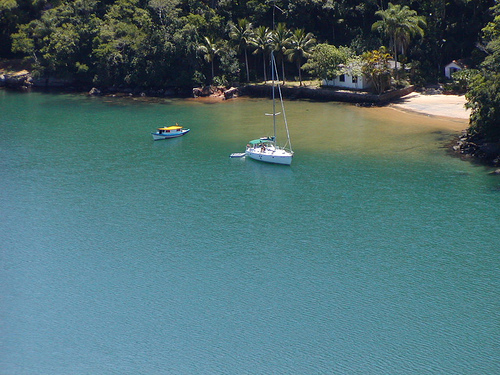
Saco do Céu is located in the cove of the stars. It is characterized by the calm sea and contoured by the mountain, as if to form a lake.
On starry nights, the stars are reflected in the water, giving that area a magical atmosphere, hence the origin of the name. Much of its coastline is formed by mangroves. In the summer, the traffic of boats is intense: Yachts, speedboats, Jet-Ski (The place is very popular for practicing the sport), parade through the green and serene sea.
Saco do Céu is a gastronomic stronghold. Excellent restaurants such as: Reis Magos, Flutuante Almirantado, Mar e Massa, among others, attract tourists and personalities from the artistic, sports and business world, who usually spend holidays and weekends in Angra.
4. VILA DE JAPARIZ

Almost all sloop tours that make the route Lagoa Azul and Freguesia de Santana, make a stop for lunch in Japariz. There is a good structure of restaurants, very affordable prices and always fresh seafood, as well as other types of dishes.
Due to its proximity to the mainland, Japariz was the headquarters for the installation of the terminal that distributed electricity to the other villages of Ilha Grande.
5. VILA DE FREGUESIA DE SANTANA
The parish was an important industrial and agricultural center in the 17th century, with extensive coffee, sugar cane and cereal plantations, as well as brandy mills. The main point is an old church, being the most important religious monument of Ilha Grande.
It was built in 1843, in the place of an old chapel, on a rectangular churchyard, supported by retaining walls. Next to it a giant coconut tree that together with the two beaches complete the exuberant scenery.
The upper beach, closer to the church, has a mooring pier and a good number of trees that provide shade on part of the beach.
The lower beach, with transparent waters and white sand, does not offer as much shade as the upper beach. There you can find two or three stalls selling snacks, soft drinks and beer.
Due to the calm and quiet sea, the place is very popular with tourists, especially on weekends, as most schooner tours that leave Angra or Abraão, include Freguesia de Santana in their itineraries.
6. LAGOA AZUL
This is a popular place for sloops and motorboats that enjoy the exuberant scenery where the green contrasts with the blue waters. In this tranquility the tourist has the perfect environment to recover the energies in full contact with nature.
A good dive and distraction with the multicolored fishes, always in great quantity, that come to the surface in search of food, are the main attractions.
Most of the tours through the bay of Ilha Grande include the Blue Lagoon in their itinerary, usually make a stop of approximately 30 minutes, enough time to contemplate the beauty of the place, dive and keep in photos the memory of a paradisiacal place.
7. VILA DE BANANAL
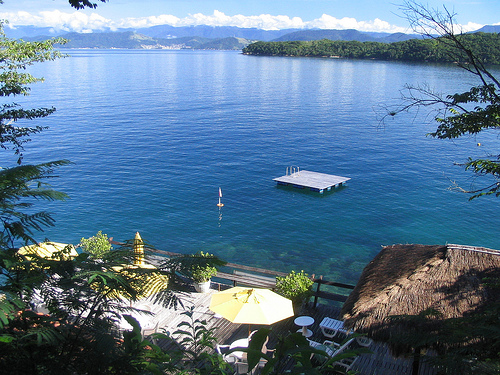
The calm and clean waters make the village of Bananal a very popular place. It is an excellent option to sleep early and rest. The tourist attractions are: boat trips, diving and ecological walks.
The inns offer good services, with maritime transportation to and from Angra dos Reis.
In Bananal as in much of the island, it already has electricity supplied by CERJ, thus giving greater comfort and convenience to tourists.
8. VILA DE MATARIZ
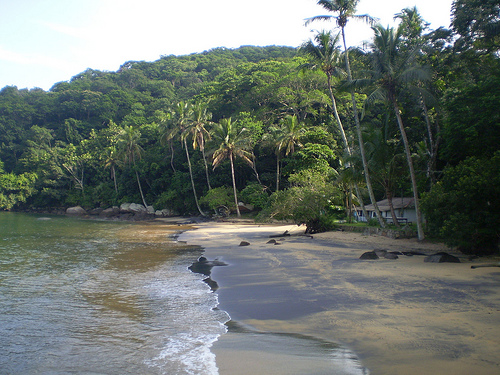
Located in the cove of Sítio Forte, near the village of Bananal. An old fish industrialization factory still exists, even deactivated, marks one of the great economic sectors of the island during the 19th century.
Matariz is not very frequented by tourists, but for those who want to get to know Ilha Grande well, the visit becomes mandatory.
9. VILA PASSATERRA
A small beach with emerald green waters. Small town but with several houses with modern construction.
In Passaterra as Ubatubinha, Maguariquissaba, Tapera and Sítio Forte, predominate colonies dedicated to fishing activity.
10. MAGUARIQUISSABA
Located in the cove of Sítio Forte, it is characterized by mussel farms. It has a mooring pier, restaurants and the clear, calm waters are suitable for swimming.
In Maguaraquissaba, the City Hall began the implementation of the Ilha Grande Mussel Cultivation project.
Today other locations are part of the project, which aims to offer residents of these localities, an alternative source of income.
11. VILLAGE OF SÍTIO FORTE
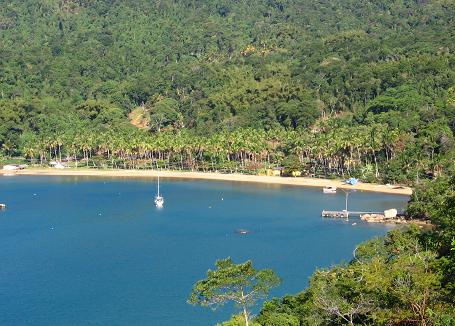
The village of Sítio Forte was once much more populated, today there are few houses, as its lands are privately owned. Very green and a beach of medium length.
The beach of Sítio Forte had an important presence in the time of slavery and sugar cane plantations. The highest parts of its coasts have dense vegetation.
The cove of Sítio Forte still displays other beaches of great beauty as: Tapera, Maguariquissaba, Passaterra and Ubatubinha.
12. TAPERA
Tapera is one of the beaches of Enseada do Sítio Forte. It is located in an indentation of the cove, the Saco da Tapera. The extreme areas of the cove are excellent for diving fishing.
Semi-deserted, long beach with a narrow strip of sand. The large coconut trees for almost all its extension completes the beauty of the place.
13. VILA UBATUBINHA
It is part of the set of beaches of Enseada do Sítio Forte. Access is facilitated because there is mooring. We also find bar and restaurant.
14. VILA DA LONGA
Vila da Longa is located in the cove of Araçatiba. Between it and Araçatiba is the Green Lagoon, a popular diving spot for sloops and motorboats that tour the bay of Ilha Grande.
Due to the proximity to the village of Araçatiba it is common to see mainly in the carnival, several people who stay in Longa and go to Araçatiba, where the excitement is greater.
15. GRANDE DE ARAÇATIBA BEACH
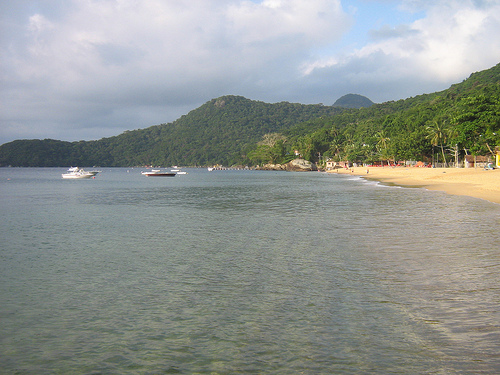
It is located on the part of Ilha Grande facing the coast of the municipality. The boat trip takes approximately 1 hour. It is an extremely quiet village, basically formed by fishermen from the region.
The number of inns is not large, but there are a good number of houses available for rent for the season. The greenish and calm waters and the exuberant forest, make Praia Grande de Araçatiba the perfect place to rest and enjoy nature. During Carnival, the number of people in the village increases a lot.
In addition to tourists, hundreds of residents, from the city center, seek tranquility in the waters of the village.
From Praia Grande de Araçatiba, you can reach other places on Ilha Grande via trails.
Following the beach towards the telephone office, a trail leads to Araçatiba Beach (Araçatibinha), soon after a fork will give us two options: Vila de Provetá and Gruta do Acaiá. Following the Acaiá trail we will pass through places of rare beauty such as Itaguaçu and Praia Vermelha, among others.
This trail lasts approximately 5:30h (round trip), at a moderate pace. The stretch that requires greater effort is just after the red beach, where a strong climb may discourage you, but do not be discouraged, because the view from up there is stunning.
Going to the other side of the beach, we have the trail that takes us to Vila da Longa, this being a much shorter path.
Camping is not allowed on the beach, but several residents rent their land for tourists to set up their tents.
16. ARAÇATIBA BEACH
Also known as Araçatibinha, it is about 20 minutes away from Praia Grande de Araçatiba. It has all the beauty requirements of the other beaches of the island, besides offering a good area, with lots of shade reserved for camping fans.
17. VERMELHA BEACH
Beautiful beach, with medium length of sand much sought after by tourists who are staying at Praia Grande de Araçatiba. The calm sea, the clear and greenish waters allied to & nbsp; restaurants on the beach are points of attraction for the constant frequency. It is approximately 45 minutes walk from Praia Grande de Araçatiba.
18. GRUTA DO ACAIÁ
Another point very popular with tourists. It is a submerged cave, which reflects sunlight through the sea water, from the inside out. The passage is narrow but does not offer danger.
To get to the cave we have to pass through a private property, where we find shower, toilet and a small bar.
During the high season there is a queue to see the cave. Avoid these days because with so much movement the water becomes quite turbid inhibiting the visual. Also take the opportunity to take a dip in the blue waters of Ponta do Acaía, which is also an exceptional point for spearfishing.
19. VILLAGE OF PROVETÁ
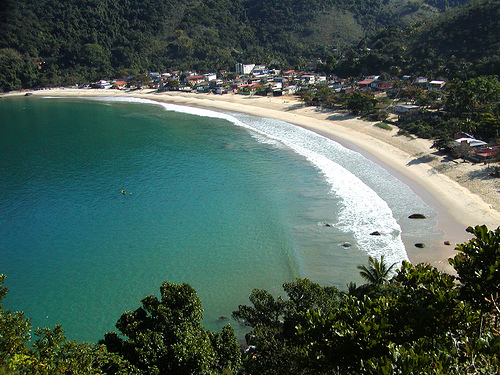
Beach of green and crystalline waters, inhabited mostly by the Protestant community of the Assembly of God.
For those who have never seen it, it is funny to see the local people bathing in the sea fully dressed, women with their skirts and blouses and men with their pants and shirts, it is a tradition of the place that has been maintained over the years. It has a good trade consisting of bars and grocery stores.
It has no hostels or camping area, but it is always easy to get camping in the grounds of the houses in the area. Despite not having regular transportation there are always fishing boats that transport residents and tourists.
20. Meros Beach
21. Ponta dos Dragos
22. AVENTUREIRO BEACH
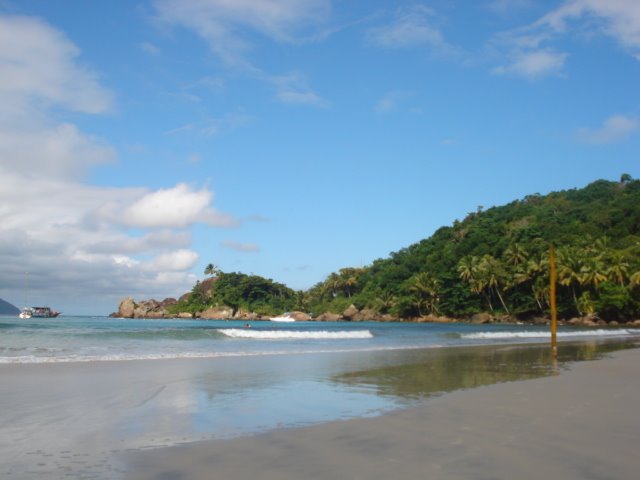
Beach with crystal clear and warm waters, small waves, and a cluster of stones where a natural pool is formed by a lying coconut tree. It looks like a movie scene, but it is real, and only Praia do Aventureiro can provide us with such a beautiful image. From time to time there is a phenomenon in the waters, the algae comes to the beach and stay to the flavor of waves, forming, on nights of moonlight, a real sky in the sea, with the reflection of the sea.
true sky in the sea, with the reflection of the moonlight hitting the seaweed, an unforgettable sight. The beach has small bars and some fishermen’s houses that serve as hostels for tourists, camping is only allowed on private property. In recent years, in summer, it is common for the beach to be very busy, many beautiful people parading through the fine sand of Aventureiro.
23. Praia do Demo
24. SOUTH BEACH
We cannot talk about Praia do Sul without first talking about Praia do Demo, which is the only path that leads to the beach. It is called Praia do Demo due to its coastline of stones that has the same name “Pedra do Demo”.
Legend has it that on a moonlit night, the daughter of a local fisherman, enchanted by the reflection of the moon on the stones, went to meet the light, climbing the wall of stones, when she was caught by the waves of the wild sea leaving the mark of her feet stuck in the rocks.
mark of his feet embedded in the stones. The Pedra do Demo is the path that leads us to Praia do Sul and we must be attentive in its crossing so that no accident happens, because on days of rough sea the waves really tend to “lick” the stones, making the path very difficult and slippery. At the end of the crossing we will see a sign indicating the beginning of the Biological Reserve of Praia do Sul and, from there, there are several kilometers of sand, sun and sea.
It is suitable for surfing, as it has a well-defined wave formation with wonderful tubes. Do not forget two important details: take your snack and the bag to bring the garbage back, because the beach is totally deserted offering no option for shopping.
25. EAST BEACH
This beach is also part of the South Beach Biological Reserve, and has the same characteristics, many kilometers of sand, sun and sea. Its great attraction, however, is the Lagoa do Leste. A lagoon with Coca-Cola colored waters that flows into the sea, transforming the border between Praia do Sul and Praia do Leste into a pool of warm and crystalline waters. In the past we could go up the river to the eastern lagoon, but IBAMA no longer allows the
without a specialized companion, as there are many snakes that like to sunbathe on the riverbank, making the route dangerous. Residents of the nearby localities say that the erosion seen on the east coast was caused by the Indians who inhabited the place many years ago. They used the coastline to carve the tips used in their arrows.
26. PARNAIOCA BEACH
Very little inhabited, with a river that flows into the green waters of the sea and small waves, they form the ideal environment for those who are after a lot of nature.
The climb up the waterfall trail is a must for those who like a cold bath in the river waters. During the summer it is common to find a tent that sells beer and soda, but in other seasons the beach is practically deserted, a place where you can find a lot of nature.
beach is practically deserted, a paradisiacal place for those who like sun, shade and fresh water.
Most sloop tours do not include Parnaioca in their itineraries, as it is located outside the island. The boat trip from Angra to Parnaioca lasts approximately 3:30h, but it will definitely be worth it.
27. Brava Beach
28. VILLAGE OF DOIS RIOS
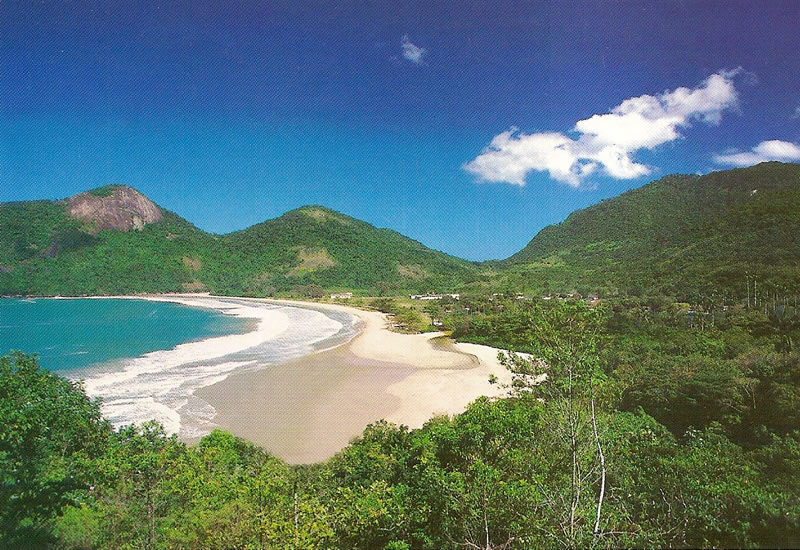
Vila de Dois rios is the place on Ilha Grande where one of Brazil’s largest prisons used to operate, the Candido Mendes Penal Institute, imploded on April 3, 1994.
Today the village is administered by the State University of Rio de Janeiro (UERJ), which in 1995 installed an advanced Center of Environmental Sciences for biological and oceanographic research.
The best way to get there is to walk along the clay road that connects Vila do Abraão to Dois Rios. Approximately 12 km, half uphill and half downhill, there is no bar or restaurant along the way but the beautiful scenery and contact with the Atlantic Forest compensate the effort.
Right at the entrance of the village huge coconut trees, further on we observe the chapel of Nossa Senhora do Bom Despacho and about 40 houses with semi deserted streets, a mysterious scenario that describes the living history of Dois Rios.
A beach approximately 1 km long, clear waters and open sea, two rivers that flow into it and give the village its name and the rubble of the old prison make the village a place of legends and stories, always sought after by tourists.
29. CAXADAÇO BEACH
Caxadaço Beach is a small piece of sand hidden between rocks and woods. Access can be done by boat or by the Abraão x Dois Rios trail. A little before arriving at the village of Dois Rios, a path on the left will take us to the beach of Caxadaço.
Water to quench thirst is not lacking, but there is no commerce in the place.
30. Santo Antônio
31. LOPES MENDES BEACH
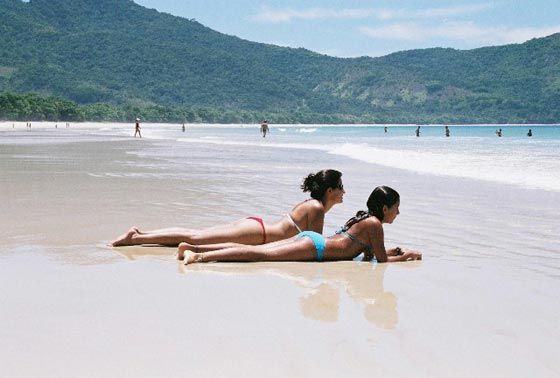
The beach of Lopes Mendes, is fantastic, the open sea provides high waves, which makes it preferred by surfers. Usually the boat trips do not reach it, because there is no pier for mooring. Usually the boats stay in Palmas, from there we leave by a trail, lasting approximately 30 minutes. Through this trail we will have some fantastic views that highlight the harmony between the sea and the Atlantic Forest.
The trail is characterized by a strong uphill stretch, which becomes very slippery when it is raining, in this case take great care. At the end of the trail you will find fine sand and flat terrain, from where you can already hear the sea beating.
It is not allowed camping on the beach, nor near it, and also has no infrastructure of bars and hostels.
32. CASTELHANOS Lighthouse
At the eastern end of the big island, near the island of Guriri is located the Castelhanos Lighthouse, built in the nineteenth century, is practically hidden by the native forest of the region.
33. Mangues – Pouso
34. ENSEADA DE PALMAS

Enseada de Palmas is very busy in the summer. It is the point of arrival for the sloop rides that go to Lopes Mendes beach. In the cove we have the beach of palms, mangroves and landing.
According to historians, the cove of Palmas, was one of the most inhabited of Ilha Grande during the nineteenth century.
From the mangrove beach to Lopes Mendes, it is about a 30-minute walk. There is no electricity and no public services
35. Abraãozinho
Camping is prohibited and there are no inns. Some houses serve snacks and meals.
TREKKING IN ILHA GRANDE
Throughout Ilha Grande there are trails that connect the beaches to each other. You should certainly have plenty of time to get to know and enjoy the tours that can be done.
Known as one of the most beautiful places in Brazil, Ilha Grande awakens in adventurers a desire to explore it from end to end. With that in mind, this itinerary aims to present the island in a way never seen before, that is, making the complete tour through deserted beaches and lots of Atlantic Forest.
An itinerary for lovers of authentic crossings, involving walks along deserted beaches with crystal clear waters, trails in the middle of the Atlantic Forest, mangroves, rocky shores and great challenges.
Trails that cut through the 193km² of Ilha Grande lead to beaches, waterfalls and secrets, you just need to be willing and have a spirit of adventure. Maps with the location of the sights to be visited are easily found, both on the internet and on the island itself.
Trails
- Circuito do Abraão – 1.700 m a 1.900 m – 1 a 1h30 min
- Aqueduto / Saco do Céu – 5.800 m a 6.000 m – 3h a 3h30 min
- Saco do Céu / Freguesia de Santana – 3.800 m a 4.000 m – 2h a 2h30 min
- Freguesia de Santana / Bananal – 2.700 m a 3.000 m – 1h a 1h30 min
- Bananal /Sitio Forte – 4.900 m a 5.000 – 2h30 min a 3h
- Sitio Forte / Praia Grande de Araçatiba – 6.000 m a 6.200 m – 3h a 3h30 min
- Praia Grande de Araçatiba / Gruta do Acaiá – 5.200 a 5.400 – 3h a 3h30 min
- Praia Grande de Araçatiba / Provetá – 4.500 m a 4.700 m – 2h30 min a 3h
- Provetá / Aventureiro – 3.500 m a 3.700 m – 2h 30 min 3h
- Abraão/Mangues/Pouso – 5.800 m a 6.000 m – 2h30 min a 3h
- Mangues/Pouso / Lopes Mendes – 1.000 m a 1.200 m – 30 min a 1h
- Mangues/Pouso – Farol dos Castelhanos – 5.800 m a 6.000 m – 3h a 3h30 min
- Abraão / Pico do Papagaio – 5.700 m a 5.900 m – 3h 3h30 min
- Abraão / Dois Rios – 6.800 m a 7.000 m – 2h30 min – 3h
- Dois Rios / Caxadaço 4.100 m a 4.300 m – 2h 2h30 min
- Dois Rios / Parnaioca – 7.600 m a 7.800 m – 3h a 3h 30 min
As trilhas a seguir não constam nas placas da Ilha Grande mas, servem de alerta para trekkings:
- Saco do Céu x Bananal – 3.000 m a 3.200 m – 1h30 min (difícil acesso. Requer experiência)
- Longa x Lagoa do Sul – (impossível ser completada e totalmente fechada pela mata)
- Provetá x Praia do Meros – 6.800 m a 7.000 m – 2h30 min – 3h (trilha fechada pela mata)
- Parnaioca x Praia do Leste – 1.500 m a 1.700 m – 0:40 a 1h (requer permissão do IBAMA)
- Caxadaço x Stº Antonio – 3.000 m a 3.200 m – 1h30 min (difícil acesso. Requer experiência)
Guia de Praias da llha Grande no Rio de Janeiro
Guia de Turismo e Viagem de Ilha Grande em Angra dos Reis
Conheça mais sobre as Ilhas continentais e ilhas oceânicas do Brasil
